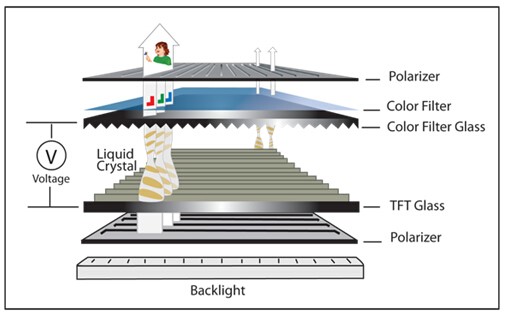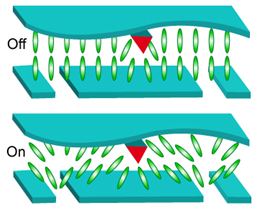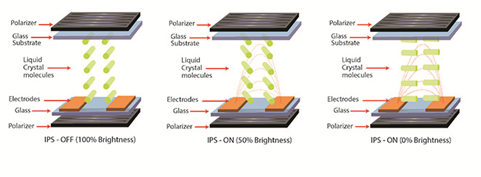CONTACT
E-mail: info@vst-display.com
TEL: 0086-13360078105
TN-TFT Display
TN-TFT is combination of traditional mono TN(Twisted Nematic) LCD technology and TFT technology, Sometimes we call it TN-film. This technology is mainly to expand the viewing angle by covering a special film on the display screen-the viewing angle can be expanded from 90 degrees to about 140 degrees. TN+Film, like standard TFT displays, realizes image control by arranging liquid crystal molecules. It covers a layer of film on the upper surface to increase the viewing angle. However, the relatively weak contrast and slow response time of TFT displays remain unchanged. So TN+Film is not a good solution, except that it is the cheapest.
The main problem with TN Film technology is that viewing angles are pretty restrictive, especially vertically, and this is evident by a characteristic severe darkening of the image if you look at the screen from below,normally we call it grayscale inversion phenomenon . Contrast and colour tone shifts can be evident with even a slight movement off-centre, and this is perhaps the main drawback in modern TN Film panels. Some TN Film panels are better than others and there have been improvements over the years to some degree, but they are still far more restrictive with fields of view than other panel technologies.

MVA-TFT display
The MVA ((Multi-domain Vertical Alignment)t technology was developed by Fujitsu of Japan. From a technical point of view, it takes into account both the viewing angle and the response time. A compromise solution was found. MVA technology allows the viewing angle to reach 160 degrees-although not as good as the 170-degree viewing angle that IPS can achieve, it is still good because this technology can provide better contrast and shorter response time.
The M in MVA stands for "multi-domains"-the meaning of multi-domain. Those purple protrusions (protrusion) constitute the so-called area. Fujitsu’s MAV displays generally have such four areas.
VA is the abbreviation of "vertical alignment", which means vertical alignment. However, literally speaking, there will be some misunderstandings, because the liquid crystal molecules are not completely vertical as the "protrusion" as shown in the figure. Please see the black schematic shown. When the voltage generates an electric field, the liquid crystal molecules are arranged parallel to each other as shown in the figure, so that the backlight light source can pass through and can diverge the light in all directions, thereby expanding the viewing angle.
In addition, MVA also provides a faster response time than IPS and TN+Film technology, which is very important for achieving good video recovery and residual visual effects. The contrast of the MVA liquid crystal display has also improved, but it will also change with the change of visibility.

How it works:
1. Light is generated from a backlight source, typically LED. Light is generated as close to white spectrum.
2. Driver ICs will logically control to activate pixels on or off.
» Inactive LCD pixels will block light
» Active pixels will open with the direction of the light to let it pass through.
3. Top Circular polarization is added to enhance contrast
4. Color is added through a color filter to all sub-pixels (R,G,B)
IPS -TFT display
IPS (In-Plane Switching) means flat panel switch, also known as Super TFT. It was first developed by Hitachi (Hitachi). The difference between this technology and the twisted nematic display (TN-Film) is that the liquid crystal molecules are arranged in parallel with the substrate when voltage is applied.

IPS TFTs were developed to improve on the poor viewing angle and the poor color reproduction of TN TFT panels at that time. The crystal molecules move parallel to the panel plane instead of perpendicular to it. This change reduces the amount of light scattering in the matrix, which gives IPS its characteristic wide viewing angles and good color reproduction. Because of its wide viewing angle and accurate color reproduction (with almost no off-angle color shift, no grayscale inversion), IPS is widely employed in high-end monitors aimed at professional graphic artists.
The name In-Plane Switching comes from the crystals in the cells of the IPS panel lying always in the same plane and being always parallel to the panel’s plane (if we don’t take into account the minor interference from the electrodes). When voltage is applied to a cell, the crystals of that cell all make a 90-degrees turn. By the way, an IPS panel lets the backlight pass through in its active state and shutters it in its passive state (when no voltage is applied), so if a thin-film transistor crashes, the corresponding pixel will always remain black, unlike with TN matrices.
IPS (In-Plane Switching) displays provide consistent, accurate color from all viewing angles without blur or grayscale inversion. IPS displays show clear images with fast response time, and no halo effect is produced when touched. Each pixel within an IPS type TFT consists of three sub-pixels (Red, Green and Blue). Each sub-pixel has a pair of electrodes to control the twisting of the Liquid Crystals. Unlike TN type TFTs where the electrodes are on opposing plates, the electrodes in an IPS TFT are on only one of the glass plates (i.e. in the same plane). When voltage is applied to the electrodes, all the Liquid Crystal molecules align in parallel with that plane and allow light to pass through to the polarizers and RGB color filters. In effect, TN displays force the Liquid Crystal molecules perpendicular to the glass which blocks some light from coming out at wide angles, while IPS displays keep the Liquid Crystal molecules in line to allow light through at all angles.

CONTACT
E-mail: info@vst-display.com
TEL: 0086-13360078105